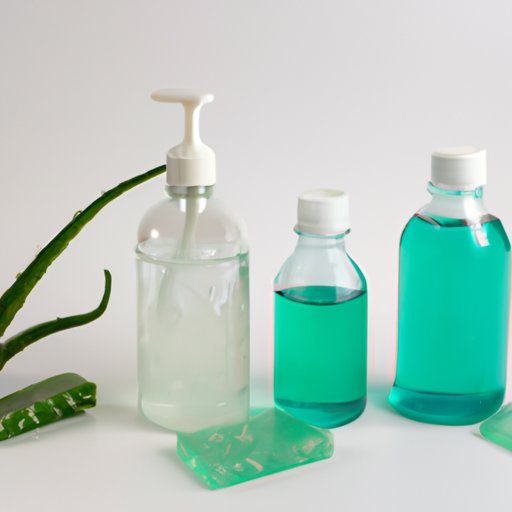
Introduction
In the wake of recent events, hygiene and cleanliness have become more important than ever. One of the most essential items to have on hand is hand sanitizer. With the high demand for sanitizer products, it can be difficult to secure a bottle from stores. The good news is that you can make your own hand sanitizer at home using simple ingredients. In this informative article, we’ll explain how to make effective hand sanitizer and also provide you with five different DIY recipes to try.
The Importance of Hand Sanitizers
Hand sanitizers are an essential tool in preventing the spread of illnesses such as colds, flu, and even the current pandemic. Sanitizer products contain a high percentage of alcohol that effectively kills germs and bacteria. They can be used when soap and water are not available and are especially useful when traveling or in public places where there is a high risk of exposure. Using hand sanitizer can provide both personal and communal benefits, as it helps to keep yourself and others healthy.
The Essential Ingredients and Tools
The most important ingredient in hand sanitizer is alcohol. To make your own sanitizer, you’ll need isopropyl alcohol (91% or higher), aloe vera gel, and essential oils, such as tea tree or lavender. Additionally, you will need a mixing bowl, spoon, funnel, sanitizer bottles, and labels.
The isopropyl alcohol is the key ingredient that effectively kills germs. Aloe vera gel serves as a thickening agent and moisturizes the skin, which is important because alcohol can be harsh and drying on the hands. Lastly, essential oils will help to impart a pleasant scent and provide extra antibacterial properties.
DIY Hand Sanitizer: A Step-by-Step Guide for Making Your Own Germ-Killing Solution
Making hand sanitizer at home is a simple process that can be done in just a few steps. Here’s what you’ll need to do:
- Using a clean mixing bowl, combine 2/3 cup of isopropyl alcohol with 1/3 cup of aloe vera gel. Mix well.
- Add 8-10 drops of essential oil and stir until fully incorporated. Do not add too much oil or it may counteract the effectiveness of the sanitizer.
- Use the funnel to carefully pour the mixture into a clean sanitizer bottle. Leave a little bit of room at the top.
- Label the bottle with the ingredients and date of preparation.
- Shake well before each use and keep stored in a cool, dry place.
Only mix small batches at a time and use clean equipment to avoid contamination.
5 Easy Homemade Hand Sanitizer Recipes You Can Make at Home
If you’re looking to personalize your hand sanitizer or cater to different skin types, here are five different variations to try:
- Citrus Sanitizer: Use lemon, lime, or orange essential oil for a fresh, citrus scent.
- Minty Fresh Sanitizer: Use peppermint or spearmint essential oil for a cool, refreshing feel.
- Herbal Sanitizer: Use rosemary or thyme essential oil for a subtle herbal fragrance.
- Floral Sanitizer: Use lavender or chamomile essential oil for a calming, floral scent.
- Sensitive Skin Sanitizer: Use glycerin instead of aloe vera gel to avoid irritation on sensitive skin.
Feel free to experiment with different oils or adjust the ratios to cater to your preferences.
Why Hand Sanitizer Is In Demand and How to Make It Yourself
Hand sanitizer has been in high demand due to the current pandemic and as a result, many stores have been out of stock. By making your own hand sanitizer at home, you can ensure that you have access to the product whenever you need it and you can also save money in the long run.
Moreover, creating your own sanitation solutions allows you to be involved in controlling the production and quality of the sanitizer to match your requirements.
Breaking Down the Science Behind Hand Sanitizer and How to Make Your Own at Home
The science behind hand sanitizer is simple. Alcohol is the primary active ingredient that fights against germs and bacteria on the skin. It works to break down the protein structure of viruses, ultimately killing the virus. Hand sanitizers containing between 60% to 95% alcohol concentration can be effective against germs. It’s important to note that hand sanitizers are not meant to replace hand-washing, but instead, to supplement it.
Here are some additional points regarding alcohol content and effectiveness:
- The percentage of alcohol is more important than the volume of sanitizer
- Higher concentration of alcohol is more effective at killing germs and bacteria
- Alcohol-based sanitizers need to evaporate for at least 20 seconds to provide full bacterial removal ability
Conclusion
Hand sanitizer is an essential item to have on hand, especially in these unprecedented times. By following our simple guide, you can make your own effective and safe hand sanitizer. Remember to prioritize good hygiene practices, such as regular hand washing and sanitizing, to keep yourself and those around you safe and healthy.





